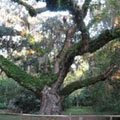Honey Horn Plantation here in South Carolina is the home of the Coastal Discovery Museum. They keep a small garden plot of local low country plants that were once important to this region. Every fall/winter they cut back their indigo patch and I was able to obtain a small amount of leaves and branches for experimentation thanks to Mira Scott who scouted the area for indigo.
These finished sample sheets await a gelatin sizing and have dried to a nice soft sage green, surprising because most green leaf plant fiber result in a tan finish. I did not have enough plant material to make more then 2 tiny pieces of fiber only paper which remained dark "spinach" green.
(I was hoping for a blueish tone -it was indigo after all)
Dried sheets - between blotters- I also loft dried in spurs and air dried several sheets. Fiber cooked with soda ash (in colander) was a very dark green.
The remaining fiber was added to my Critter beater with 2lbs of cotton linter and still a nice dark blue/green pulp was the result before drying.
more cotton linter added to extend the batch...... a pale sage paper.
Leaves and small stems of indigo processed for cooking. The thicker stems were saved for possible bast fiber use....BUT bast too thin !!! not usable...
"IN" the indigo with friend and artist Mira Scott (left) at Honey Horn.














.JPG)

.JPG)















